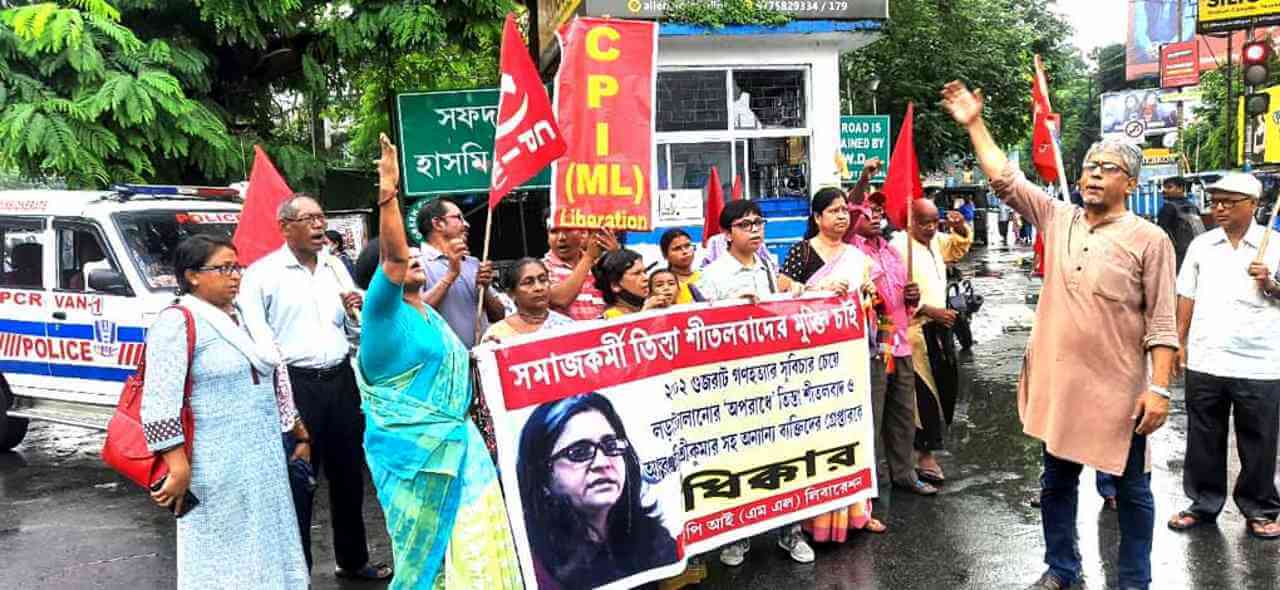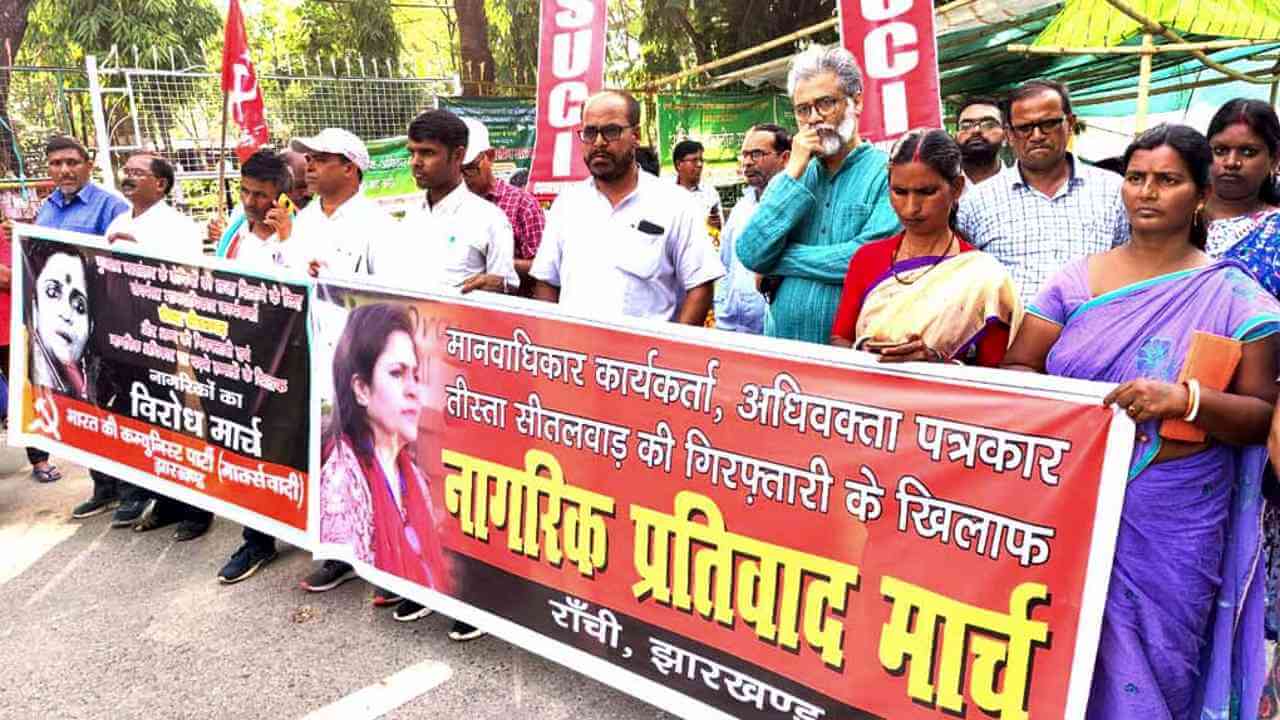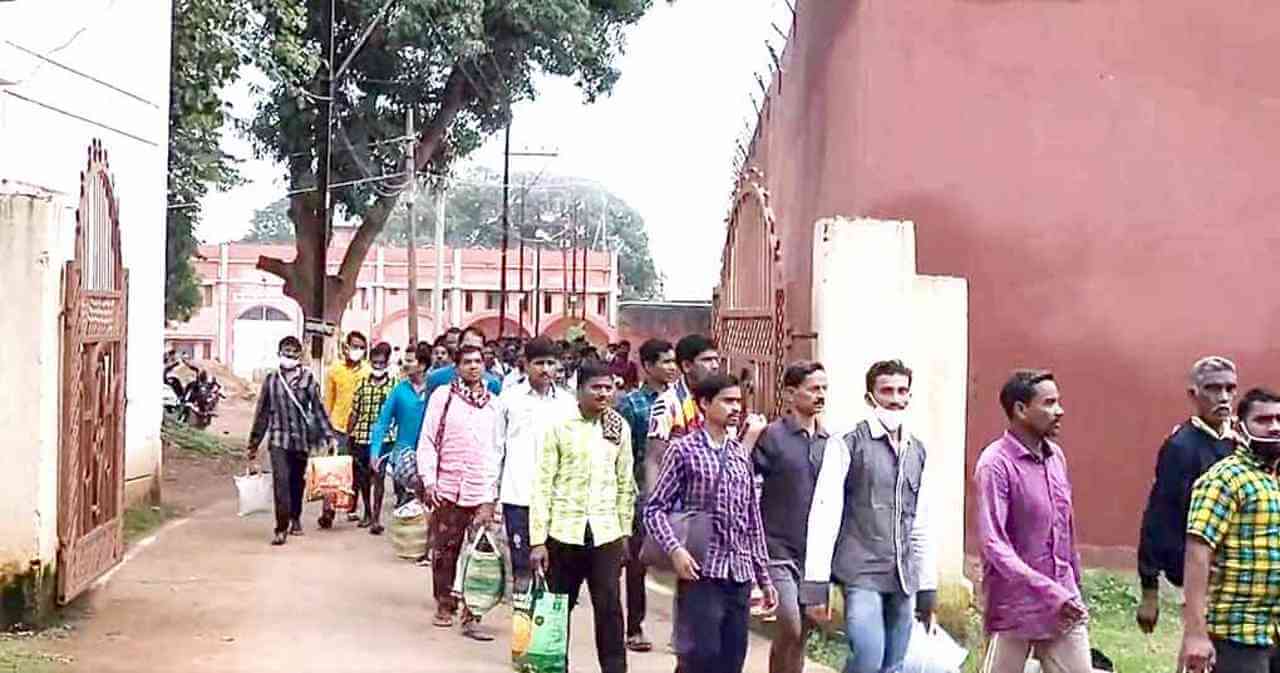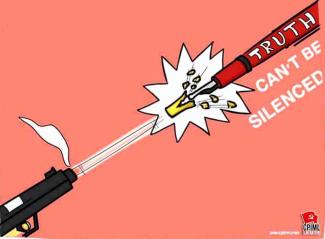In a democracy, the judiciary is meant to be independent from the executive; and citizens are meant to have the right to appeal to courts for action against the government, police/armed forces, and bureaucracy. The courts bear the responsibility of protecting the liberties and rights of the individual citizen from the overreaching might of the state. If the judiciary begins to obey the political executive (i.e the government), and even to then democracy is on its deathbed.
The overturning of the 1973 Roe v Wade judgment that had recognised women’s constitutional right to abortion by the US Supreme Court has alerted the world to the fragility of democracy in that country. In India, the judicial institutions have never been all that robust. During the Emergency that lasted between 1975-77, the Supreme Court of India notoriously ruled in favour of the Indira Gandhi government’s right to suspend habeas corpus – i.e the individual’s right not to be unlawfully detained – in the ADM Jabalpur case. It was only in retrospect, after Emergency ended, that Justice Khanna’s dissenting judgment in that case came to be hailed and upheld.
Two successive recent Supreme Court judgments toll the death knell for India’s democracy, warning of a crisis for India’s judicial independence that is far more life-threatening that its chronic weaknesses. In these two unprecedented judgments, the Supreme Court obediently took the stance advocated by the Solicitor General of India, appearing respectively for the Gujarat Government and the Union Government, and ordered the criminalisation of human rights defenders who had enabled survivors of massacres to navigate the judicial maze and seek justice.
In India, massacres of vulnerable communities – adivasis, dalits, Muslims, Christians, Sikhs, Kashmiris, Manipuris, Nagas – have always been a grim reality; as have been cases in which individuals and groups from these communities have been framed for crimes they did not commit, and unjustly imprisoned as under-trials for long years. Justice has always been elusive in such cases. The police is often complicit with perpetrators of massacres; and moreover proving guilt of individual members of violent mobs in a court of law is not easy. And ‘national security’ has often been a pretext to suspend liberties of individuals from these communities falsely charged under draconian anti-terror laws; or to block efforts to hold armed forces responsible for killings of individuals from these communities in the name of counter-insurgency operations. The task – essential to keep democracy alive but often risky and thankless – of seeking justice in such cases has fallen to human rights and civil liberties defenders.
For the past several years, we have seen the Modi regime use the UAPA and other draconian laws to effectively suspend habeas corpus and imprison human rights defenders, political dissenters, and journalists as under-trials for years at a time, with no end in sight. Courts, including the Supreme Court, have for the most part failed to defend the liberties of these citizens. One such activist, Stan Swamy, an octogenarian priest with Parkinson’s disease who was a crusader for the unjustly incarcerated adivasi prisoners in Jharkhand, died in prison without bail, as an under-trial UAPA prisoner in the Bhima Koregaon case where the ‘investigative’ agencies have not even bothered to hide their tracks as they planted and fabricated evidence. Sudha Bharadwaj is another activist known for her work to secure the release of indefinitely incarcerated adivasi undertrials, and justice for adivasi victims of custodial killings in Chhattisgarh, who is also an accused in the Bhima Koregaon case.
Journalist Mohd. Zubair, targeted in multiple criminal cases for having called Hindu-supremacists like Yati Narsinghanand and Bajrang Muni, “hate-mongers” for their speeches calling for genocide and rape of Muslims, was granted bail by the Supreme Court after 23 days; meanwhile Nupur Sharma, who was removed from the position of BJP’s spokesperson after international outrage over her hate-mongering speech, also got bail – without having had to spend a single day in prison. But other journalists, who are also Muslim, like Siddique Kappan continue to languish in prison just for doing their job – and courts remain apathetic and fail to protect their liberties.
But with the two SC judgments to which we refer, the judiciary has not merely failed to safeguard civil liberties from the attacks by the state. Instead, these are cases in which the state has handed off its weapon of attack to the judiciary. The judiciary has heeded the voice of government and acted to punish the human rights defenders and members of vulnerable groups that petitioned it for protection and justice! If the judiciary deems it ‘conspiracy’ or even ‘terrorism’ for citizens to approach the courts seeking to hold the government, police and armed forces responsible, then all doors of justice are shut to the citizen. And a country where the judiciary slams its doors shut and orders citizens to face fines and prosecution simply for petitioning Supreme Court, is not a democracy.


Modi-Shah’s Revenge on Teesta?
A day after the Supreme Court dismissed Zakia Jafri’s petition appealing a lower court’s refusal to file a case against Narendra Modi for his role in Gujarat’s anti-Muslim violence of 2002, the anti-terrorism squad (ATS) of the Gujarat policy arrested activist Teesta Setalvad and former Gujarat intelligence officer RB Shreekumar on the basis of an FIR registered by the crime branch of the Ahmedabad police.
Dismissing the petition, the Supreme Court of India said, without referencing any facts, “The protagonists of the quest for justice sitting in a comfortable environment in their air-conditioned office may succeed in connecting failures of the state administration at different levels during such a horrendous situation, little knowing or even referring to the ground realities and the continual effort put in by the duty holders in controlling the spontaneous evolving situation unfolding aftermath mass violence across the state.”
The chronology is clear: the arrests of human rights defenders follow language by the Supreme Court of India framing “protagonists of the quest for justice” as conspirators for seeking to hold the Gujarat State machinery accountable for targeted violence. To make the chronology even clearer, the FIR filed by the Gujarat ATS quotes excerpts from the judgment in order to justify its actions against Teesta Setalvad and others. This detention also comes a day after Home Minister Amit Shah made a statement against Teesta.
Setalvad’s organisation, Citizens for Justice and Peace, has tirelessly pursued cases relating to the 2002 anti-Muslim massacres in Gujarat that took place under Narendra Modi as Chief Minister: especially the Gulberg Society and Naroda Patiya killings. The Naroda Patiya case led to the conviction of prominent BJP leader and former minister Maya Kodnani. When Gulberg Society where he lived was attacked, former MP Ehsan Jafri gave shelter to terrified Muslims. He called the then CM Narendra Modi as well as other persons in authority for help when his home was surrounded by a murderous Hindu-supremacist mob. No help arrived - and Ehsan Jafri was tortured and burnt alive. His wife Zakia Jafri since then courageously pursued the quest for truth and justice in the courts for the past two decades, seeking to establish the complicity of the 2002 Gujarat Government headed by the CM Modi in the targeted violence. She was supported in this quest for justice by Teesta Setalvad and her organisation Citizens For Justice and Peace. A number of public servants who served in Gujarat in 2002 including R.B. Shreekumar refused to perjure themselves to defend the Gujarat Government of the day headed by the then CM Narendra Modi, and have consistently spoken their truth to serve the cause of justice.
In all, Setalvad and her organisation helped secure 120 convictions in 68 cases involving nine major Gujarat riot incidents: a rare achievement when perpetrators in most cases of targeted caste and communal massacres in India go scot-free. The Supreme Court bench admitted the Gujarat Government’s failure to control the riots. The fact is that the Gujarat Government of the time also failed to pursue justice for the victims. In fact the Supreme Court had had to order the cases to be tried outside Gujarat – a key factor that prevented the Gujarat Government from silencing survivors and witnesses and made convictions possible in so many cases. How can the judges on the SC bench now brand the quest for justice, facilitated by the SC institution itself, to be a conspiracy of politically motivated elites in “air-conditioned rooms”? The Supreme Court bench’s observations encouraged the same police that failed to prevent a massacre, to criminalise activists who sought to hold them accountable.
Punished For Filing FIR In Massacre Case
An adivasi woman Draupadi Murmu is now the President of India. Coinciding with this moment, the Supreme Court of India accepted the Government of India’s recommendation to treat adivasi women seeking justice against a massacre by police and paramilitary forces, as conspirators and criminals. The same BJP which touts its choice of Ms Murmu as President as an act of symbolic inclusion, is criminalising any attempt by adivasi women to seek justice against systemic violence by the state’s armed forces.
In the second judgment of its kind, the Supreme Court again criminalised petitioners for justice in its own court. On 14 July, the SC criminalised the Gandhian activist Himanshu Kumar and 12 adivasi villagers who had petitioned the Supreme Court for an impartial enquiry into the Gompad massacre of adivasis in Sukma district of Chhattisgarh in 2009. The Gompad massacre included two incidents of violence on September 17 and October 1, 2009 in which at least seventeen adivasi people from the villages of Gachchanpalli, Gompad, Nulkatong and other villages near the Singanmadgu forest were killed. The petitioners include survivors of the killings who were themselves injured; as well as family members of those who were killed.
In this judgment the court has adopted the following reasoning: that since the FIRs lodged by the writ petitioners at the different police stations alleging massacre by police and paramilitary forces, were investigated, and the investigating agency concluded that it was Maoists rather than the police force that had perpetrated the massacre, “Prima facie, it could be said that false information was given by the first informants to the police as regards the alleged massacre by the police force.”
This reasoning sets a dangerous precedent that will deter survivors and witnesses in massacre cases from even filing FIRs, if they risk being punished for doing so in the event that the court fails to prove their allegations. Moreover, the Government of India’s own submission to the Supreme Court, and the submissions of the CoBRA battalion and the government of Chhattisgarh, make assertions that contradict each other. They accuses Himanshu Kumar of falsely seeking to portray Maoists killed in an encounter as “innocent tribal victims massacred by security forces”; while at the same time accusing him of seeking to pass off a massacre by Maoists as one by security forces.
Contradictory Claims
The petitioners had sought an independent investigation into the Gompad massacre. Survivor accounts appearing in the immediate aftermath of the massacre had stated that Chhattisgarh police and the CoBRA battalion of CRPF had stabbed and shot dead several villagers, and injured many including a baby.
In its submission to the Supreme Court, the Union of India accused Himanshu Kumar of manipulating “illiterate” and “rustic” villagers to file the petitions because he had “a malafide objective to change the narrative of the (Gompad) incident and with malicious designs i.e. to portray the dreaded Left Wing Extremists (Naxals), who were waging an armed rebellion against the security forces of the country and threatening the sovereignty and integrity of the country, as innocent tribal victims being massacred by the security forces.” This part of the petition clearly suggests that according to the Union Government, those killed at Gompad were ‘Left Wing Extremists’ (i.e Maoists), presumably killed in an armed encounter by ‘security forces’, and not ‘innocent tribals’.
But in the same submission, the Union of India pointed out that in front of the magistrate who had conducted the investigation in Chhattisgarh, the villagers had not accused the ‘security forces’ of the killing, and had only said that “persons came from the jungle had murdered and brutalized villagers.” Based on this, the UoI implies, and the SC accepts the implication, that “There are frequent reports of civilian killings and torture of innocent by naxalite cadres wearing security forces’ uniforms to terrorize the masses in the name of maoist ideology and they might have indulged in such acts to defame the security forces and demoralize them with the intention to stall and derail operations in their strong hold areas.” (emphasis ours)
The petitioners are seeking an independent investigation into incidents in which 17 villagers were killed. According to the central government, who killed these 17 adivasis; and who were these 17 victims? In the same submission, the central government suggests that the 17 people killed were “villagers” killed by Maoists posing as “security forces”; and also that they were Maoists killed by security forces, whom the petitioners seek to pass off as “innocent tribal victims.” Both claims cannot be true at the same time; and no evidence is offered by the government to back either of these claims.
The State of Chhattisgarh’s affidavit offers this narrative: “A team of security forces consisting of CoBRA, local police and SPOs had started off on 30.09.2009 for Gompad village on the information of a naxal camp being run near village. When police party was about to reach the village at 06:30 AM on 01.10.2009, it came under heavy fire by Naxalites. The attack was repulsed and place was searched. Police did not find anybody. Afterwards the village was also searched but everyone fled away.” So the Chhattsigarh government is stating that on the date in question, police, Special Police Officers and CoBRA forces ‘repulsed’ an attack by Maoists in Gompad: i.e that an ‘encounter’ took place. It does not state how the 17 people might have died.
The CoBRA 201 battalion’s affidavit also admits that it was part of a violent incident in Gompad on the date in question; and claims it fired in self defence in reply to a Maoist attack: “When CoBRA/SAF troops were about 01 Km short of village Gompad at about 0630 hrs on 01/10/09 naxalites ambushed the troops and opened heavy fire. CoBRA/SAF troops had no other option and were forced to retaliate the fire which lasted for about 20 minutes and naxalites fled away from the ambush site. When the naxalites were fleeing they were seen carrying their injured colleagues.”
So CoBRA is admitting that their fire injured some people, whom they claim were ‘naxalites’, i.e Maoists. The implication is that those killed were in fact Maoists killed in this encounter.
The CoBRA affidavit makes a vague and garbled allegation against the petitioners: “this strong action of the CoBRA/SAF Bn was highly appreciated and published in the local newspapers. Hence, the petitioners in connivance with the naxalites have falsely alleged against the local police and SAF 201 to stall the operations against naxalites with well thought out nefarious designs.” What is clear is that neither the Chhattisgarh government nor the CoBRA battalion is claiming that Maoists wore uniforms of security officers and killed villagers in a false flag attack, which Himanshu Kumar later dressed up as a massacre by security forces. Instead both these entities are admitting that exactly as alleged by Himanshu Kumar and the other petitioners, the police along with SPOs and CoBRA forces did fire at people in Gompad on the date in question. The only difference is, the Chhattisgarh government and CoBRA battalion claim they fired in self-defence in an ‘encounter’ with armed Maoists; and they admit no deaths though they imply that those killed were Maoists who must have succumbed to their injuries after their comrades took them away. And the petitioners allege that these claims of an ‘encounter’ are false; and in fact ordinary villagers were killed by police, SPOs and CoBRA forces. Which of these two claims is right, could be established only if an impartial investigation took place – but the Supreme Court did not agree to order such an investigation.
Instead the SC accepted a third narrative entirely, offered by the central government without any evidence to back it, that the victims were villagers killed by Maoists dressed up as ‘security forces’!
The SC judgment does not even attempt to make sense of this garbled set of contradictory claims. It simply accepts the political allegation made by the central government, which is that Himanshu Kumar and other human rights activists like him are just fronts for Maoists, trying to defame ‘security forces’ in order to damage the counter-insurgency efforts, and that such activists must face punishment to deter them from making such allegations in future.
Here one may recall that in 2010, it was the Supreme Court which had rebuked the Chhattisgarh Government for raising the "bogey" of Naxalism to discredit those raising issues of human rights violations. "Suppose somebody fights their (victims) case, so what does that imply? First you say they are Naxals, then you say they are sympathisers, then you say they are sympathisers of sympathisers, why all these innuendos. You mean to say they (human rights activists) should not be concerned with human rights and fundamental rights? Don't keep bringing this Naxal issue. The only issue before this court is whether any such incident has happened or not. Naxals are not before us. Why is the issue being repeatedly raised before us about those who are not before us? We are concerned with the short question whether security forces had conducted themselves in such a fashion. If prima facie there is something... even if there is slightest suspicion we have to examine," a bench of Justices B Sudershan Reddy and S S Nijjar had said to the Chhattisgarh government at the time.
In contrast, in 2022, the same Supreme Court has been eager to accept any flimsy explanation, minus evidence, for the killing of 17 villagers; and has leaped to embrace and legitimise the “Maoist bogey”!

A History of Custodial Killings And Imprisonment of Innocents
Even as the Supreme Court appears to be encouraging the government to arrest and prosecute adivasi petitioners and their supporters like Himanshu Kumar, an NIA court in Chhattisgarh acquitted 121 adivasis five years after they were booked under UAPA on charges of conspiring with Maoists to kill 25 Central Reserve Police Force personnel in Burkapal in 2017. Innocent adivasi villagers lost five years of their lives inside prison walls – and the police and administration that made them scapegoats faces no consequences, and is not called upon to make even an apology, let alone any reparations.
The Burkapal acquittal raises the question: why are police not being booked for criminal conspiracy when their allegations fail to be proved; if human rights activists filing FIRs in massacre cases can be booked for the same? As a statement by Chhattisgarh civil liberty groups pointed out, “The judgment in the case of Himanshu Kumar & Others holds that since the petitioners were unable to prove their accusations against the Police and the Security Forces, hence the entire petition has malicious intent, and may even be a criminal conspiracy. This logic is fallacious in itself. It is well known that in the district of Dantewada alone, the acquittal rate of adivasi persons booked in Naxalite cases is over 95%, year after year. A study of 101 cases of UAPA registered in Bastar Sessions Court in 2015 showed that 92 of such cases resulted in acquittals, the remaining 9 were transferred to other courts, and not a single case resulted in a conviction. Does that mean that the entire police force in Bastar should be imprisoned for criminal conspiracy?”
The same statement also points out that “By rejecting the plea for an independent investigation, this judgment turns the principle of natural justice on its head. It should be recalled that it was the result of people’s demand for an independent investigation that resulted in the CBI inquiry into the violent incidents at Tadmetla, Morpalli and Timmapuram during Salwa Judum in 2011, and the inquiry by the National Human Rights Commission into the incidents of mass sexual violence in Bijapur and Sukma districts in 2015-2016. Both of these investigations corroborated the villagers’ allegations of mass violence conducted by security forces.” When such allegations have time and again been proved true, what is the basis for the Union of India’s claim of a conspiracy by Maoist-backed activists to falsely accuse ‘security forces’ of atrocities against unarmed adivasi villagers?
Process Is Punishment
Speaking at a recent event, Chief Justice of India N.V. Ramana admitted the problem, saying “In our criminal justice system, the process is the punishment. From hasty indiscriminate arrests, to difficulty in obtaining bail, the process leading to the prolonged incarceration of under-trials needs urgent attention.” The question arises, why are the CJI’s brother judges enabling a vindictive government to weaponise the criminal justice process to punish the very same human rights defenders who are only ones seeking to repair the criminal justice system that even the CJI admits is broken?
The oppressed caste and minority victims of the Bathani Tola (1996) and Laxmanpur Bathe (1997) massacres in Bihar have been waiting since 2012 for the Supreme Court to hear their petition to overturn the Patna High Court’s mass acquittal of all the accused. Will the witness-survivors who filed the petitions now have to fear that the Supreme Court will not only deny them justice, but will penalise and criminalise them and the movements that enabled their quest for justice?
Even in the face of government-sponsored judicial injustice, people’s quest for justice will survive, and eventually triumph.











